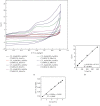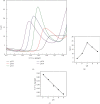An Electrochemical Sensor Based on Gold Nanodendrite/Surfactant Modified Electrode for Bisphenol A Detection
- PMID: 33457037
- PMCID: PMC7785347
- DOI: 10.1155/2020/6693595
An Electrochemical Sensor Based on Gold Nanodendrite/Surfactant Modified Electrode for Bisphenol A Detection
Abstract
In the present work, we reported the simple way to fabricate an electrochemical sensing platform to detect Bisphenol A (BPA) using galvanostatic deposition of Au on a glassy carbon electrode covered by cetyltrimethylammonium bromide (CTAB). This material (CTAB) enhances the sensitivity of electrochemical sensors with respect to the detection of BPA. The electrochemical response of the modified GCE to BPA was investigated by cyclic voltammetry and differential pulse voltammetry. The results displayed a low detection limit (22 nm) and a linear range from 0.025 to 10 µm along side with high reproducibility (RSD = 4.9% for seven independent sensors). Importantly, the prepared sensors were selective enough against interferences with other pollutants in the same electrochemical window. Notably, the presented sensors have already proven their ability in detecting BPA in real plastic water drinking bottle samples with high accuracy (recovery range = 96.60%-102.82%) and it is in good agreement with fluorescence measurements.
Copyright © 2020 Nguyen Thi Lien et al.
Conflict of interest statement
The authors declare that they have no conflicts of interest.
Figures







References
-
- Malone E. M., Elliott C. T., Kennedy D. G., Regan L. Rapid confirmatory method for the determination of sixteen synthetic growth promoters and bisphenol a in bovine milk using dispersive solid-phase extraction and liquid chromatography-tandem mass spectrometry. Journal of Chromatography B. 2010;878(15-16):1077–1084. doi: 10.1016/j.jchromb.2010.03.012. - DOI - PubMed
-
- Kim Y., Jeon J. B., Chang J. Y. CdSe quantum dot-encapsulated molecularly imprinted mesoporous silica particles for fluorescent sensing of bisphenol A. Journal of Materials Chemistry. 2012;22(45):24075–24080. doi: 10.1039/c2jm34798a. - DOI
LinkOut - more resources
Full Text Sources

